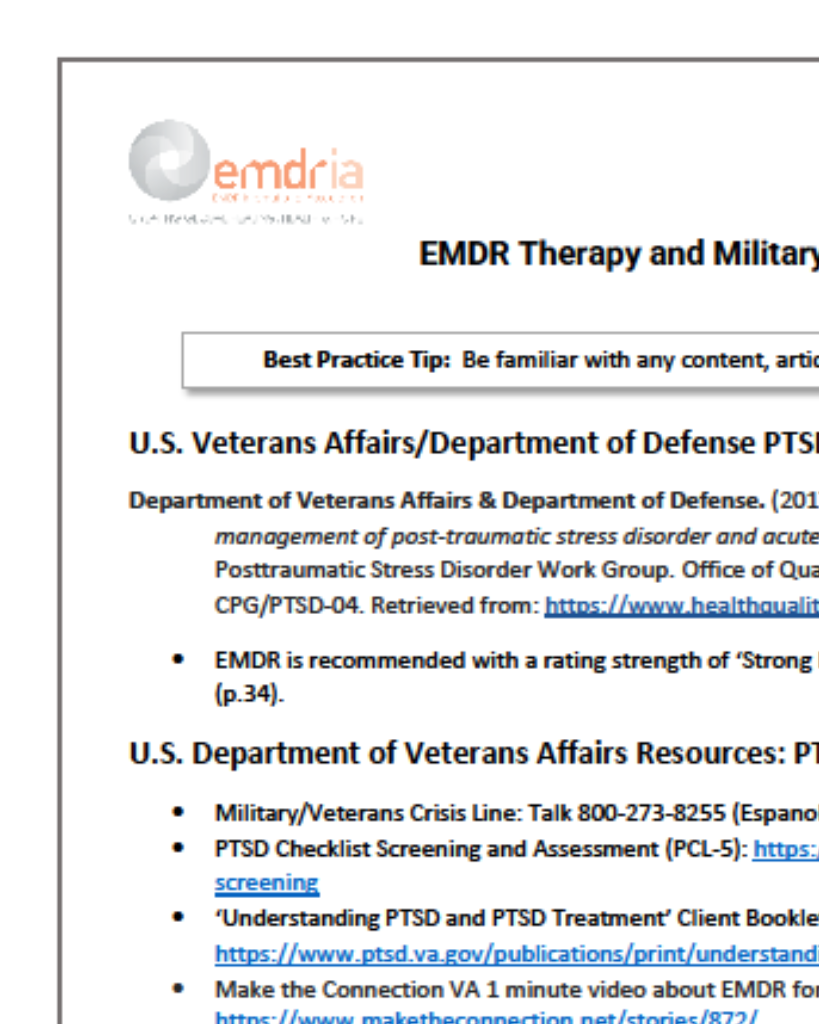Effectiveness of treating post-traumatic stress disorder in patients with co-occurring substance use disorder with prolonged exposure, eye movement desensitization and reprocessing or imagery rescripting: A randomized controlled trial
Three different PTSD treatments were compared, added simultaneously to SUD treatment, with SUD treatment alone in patients with co-occurring SUD-PTSD: Prolonged Exposure (PE), EMDR therapy, and Imagery Rescripting (ImRs).
Article Abstract
“Background and aims: Post-traumatic stress disorder (PTSD) and substance use disorder (SUD) are highly co-occurring and evidence for the optimal ways of treating PTSD in SUD patients is mixed. Our aim was to compare three different PTSD treatments, each added simultaneously to SUD treatment, with SUD treatment alone in patients with co-occurring SUD-PTSD. These PTSD treatments were: Prolonged Exposure (PE), Eye Movement Desensitization and Reprocessing (EMDR) and Imagery Rescripting (ImRs).
Design: A single-blind 4-arm randomized controlled trial with follow-up at 3 months.
Setting: Two addiction treatment centers in the Netherlands, providing intra- and extramural care.
Participants: 209 patients with SUD and co-morbid PTSD were included [mean age 37.5 (standard deviation, SD = 11.99), female sex = 46.4%, mean Clinically Administered PTSD Scale (CAPS) score = 37.35 (SD = 9.28)].
Interventions: Participants were randomized to either simultaneous SUD + PE (n = 53), SUD + EMDR (n = 50), SUD + ImRs (n = 55) or to SUD treatment only (n = 51), with the active PTSD treatments consisting of 12 sessions each within 3 months. Standard protocols were used.
Measurements: The primary outcome was clinician-administered PTSD symptom severity as measured by Diagnostic and Statistical Manual of Mental Disorders, Fifth Edition (CAPS-5) at 3 month follow-up. Secondary outcomes included loss of PTSD diagnosis, full remission of PSTD and SUD-severity, also recorded at 3 months.
Findings: Compared with SUD only, the mean differences in CAPS-5 score were B = −5.41 [95% confidence interval (CI) = 10.88, 0.05, P = 0.052] for SUD + PE, B = −7.97 (95% CI = −13.57, −2.37, P = 0.006) for SUD + EMDR and B = −10.03 (95% CI = −15.29, −4.77, P < 0.001) for SUD + ImRs. When adjusted for baseline covariates, mean differences were B = −5.81 (95% CI = −11.48, −0.15, P = 0.044) for SUD + PE, B = -8.85 (95% CI = −14.60, −3.10, P = 0.003) for SUD + EMDR and B = -10.75 (95% CI = −15.94, −5.56, P = <0.001) for SUD + ImRs. No between-group differences in SUD outcomes were found.
Conclusions: Among people with co-occurring substance use disorder (SUD) and post-traumatic stress disorder (PTSD), trauma-focused PTSD treatment as add-on to SUD treatment appears to be effective in decreasing PTSD severity compared with manualized SUD only treatment and does not appear to increase SUD severity.
Funding information: This work was funded by the Dutch ‘Stichting tot steun VCVGZ’, which assigned a grant to Prof. Arnoud Arntz, Dr Marleen de Waal, Dr Loes Marquenie and Prof. Goudriaan at the University of Amsterdam (grant no. 244). The funder had no role in the design, data collection, data analysis and reporting of this study.”
—Description from publisher
Article Access
Purchase/Subscription Required
Lortye, S., Will, J. P., Marquenie, L. A., Lommerse, N. M., Faber, N., Goudriaan, A. E., Arntz, A., & de Waal, M. M. (2025). Effectiveness of treating post-traumatic stress disorder in patients with co-occurring substance use disorder with prolonged exposure, eye movement desensitization and reprocessing or imagery rescripting: A randomized controlled trial. Addiction, Online First. https://doi.org/10.1111/add.70097
Date
May 29, 2025
Creator(s)
Sera Lortye, Joanne P. Will, Loes A. Marquenie
Contributor(s)
Nick M. Lommerse, Nathalie Faber, Anna E. Goudriaan, Arnoud Arntz, Marleen M. de Waal
Topics
Addictions, PTSD
Practice & Methods
Comparative Studies
Publisher
Wiley
APA Citation
Lortye, S., Will, J. P., Marquenie, L. A., Lommerse, N. M., Faber, N., Goudriaan, A. E., Arntz, A., & de Waal, M. M. (2025). Effectiveness of treating post-traumatic stress disorder in patients with co-occurring substance use disorder with prolonged exposure, eye movement desensitization and reprocessing or imagery rescripting: A randomized controlled trial. Addiction, Online First. https://doi.org/10.1111/add.70097
Audience
EMDR Therapists, Other Mental Health Professionals
Language
English
Content Type
Article, Peer-Reviewed, RCT
Access Type
External Resource




